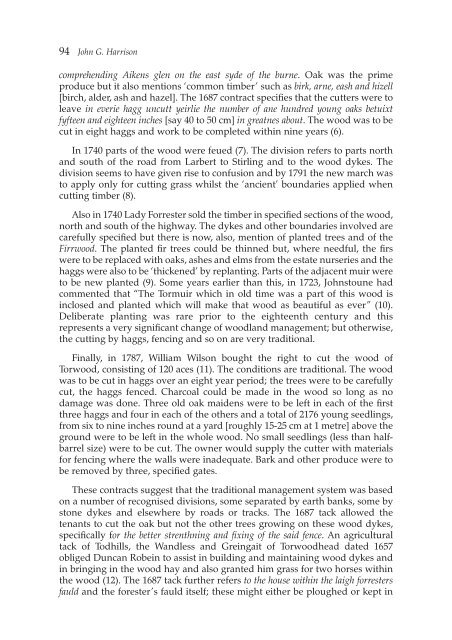the Forth Naturalist Historian - Forth Naturalist and Historian ...
the Forth Naturalist Historian - Forth Naturalist and Historian ...
the Forth Naturalist Historian - Forth Naturalist and Historian ...
Create successful ePaper yourself
Turn your PDF publications into a flip-book with our unique Google optimized e-Paper software.
94 John G. Harrison<br />
comprehending Aikens glen on <strong>the</strong> east syde of <strong>the</strong> burne. Oak was <strong>the</strong> prime<br />
produce but it also mentions ‘common timber’ such as birk, arne, eash <strong>and</strong> hizell<br />
[birch, alder, ash <strong>and</strong> hazel]. The 1687 contract specifies that <strong>the</strong> cutters were to<br />
leave in everie hagg uncutt yeirlie <strong>the</strong> number of ane hundred young oaks betuixt<br />
fyfteen <strong>and</strong> eighteen inches [say 40 to 50 cm] in greatnes about. The wood was to be<br />
cut in eight haggs <strong>and</strong> work to be completed within nine years (6).<br />
In 1740 parts of <strong>the</strong> wood were feued (7). The division refers to parts north<br />
<strong>and</strong> south of <strong>the</strong> road from Larbert to Stirling <strong>and</strong> to <strong>the</strong> wood dykes. The<br />
division seems to have given rise to confusion <strong>and</strong> by 1791 <strong>the</strong> new march was<br />
to apply only for cutting grass whilst <strong>the</strong> ‘ancient’ boundaries applied when<br />
cutting timber (8).<br />
Also in 1740 Lady Forrester sold <strong>the</strong> timber in specified sections of <strong>the</strong> wood,<br />
north <strong>and</strong> south of <strong>the</strong> highway. The dykes <strong>and</strong> o<strong>the</strong>r boundaries involved are<br />
carefully specified but <strong>the</strong>re is now, also, mention of planted trees <strong>and</strong> of <strong>the</strong><br />
Firrwood. The planted fir trees could be thinned but, where needful, <strong>the</strong> firs<br />
were to be replaced with oaks, ashes <strong>and</strong> elms from <strong>the</strong> estate nurseries <strong>and</strong> <strong>the</strong><br />
haggs were also to be ‘thickened’ by replanting. Parts of <strong>the</strong> adjacent muir were<br />
to be new planted (9). Some years earlier than this, in 1723, Johnstoune had<br />
commented that “The Tormuir which in old time was a part of this wood is<br />
inclosed <strong>and</strong> planted which will make that wood as beautiful as ever” (10).<br />
Deliberate planting was rare prior to <strong>the</strong> eighteenth century <strong>and</strong> this<br />
represents a very significant change of woodl<strong>and</strong> management; but o<strong>the</strong>rwise,<br />
<strong>the</strong> cutting by haggs, fencing <strong>and</strong> so on are very traditional.<br />
Finally, in 1787, William Wilson bought <strong>the</strong> right to cut <strong>the</strong> wood of<br />
Torwood, consisting of 120 aces (11). The conditions are traditional. The wood<br />
was to be cut in haggs over an eight year period; <strong>the</strong> trees were to be carefully<br />
cut, <strong>the</strong> haggs fenced. Charcoal could be made in <strong>the</strong> wood so long as no<br />
damage was done. Three old oak maidens were to be left in each of <strong>the</strong> first<br />
three haggs <strong>and</strong> four in each of <strong>the</strong> o<strong>the</strong>rs <strong>and</strong> a total of 2176 young seedlings,<br />
from six to nine inches round at a yard [roughly 15-25 cm at 1 metre] above <strong>the</strong><br />
ground were to be left in <strong>the</strong> whole wood. No small seedlings (less than halfbarrel<br />
size) were to be cut. The owner would supply <strong>the</strong> cutter with materials<br />
for fencing where <strong>the</strong> walls were inadequate. Bark <strong>and</strong> o<strong>the</strong>r produce were to<br />
be removed by three, specified gates.<br />
These contracts suggest that <strong>the</strong> traditional management system was based<br />
on a number of recognised divisions, some separated by earth banks, some by<br />
stone dykes <strong>and</strong> elsewhere by roads or tracks. The 1687 tack allowed <strong>the</strong><br />
tenants to cut <strong>the</strong> oak but not <strong>the</strong> o<strong>the</strong>r trees growing on <strong>the</strong>se wood dykes,<br />
specifically for <strong>the</strong> better strenthning <strong>and</strong> fixing of <strong>the</strong> said fence. An agricultural<br />
tack of Todhills, <strong>the</strong> W<strong>and</strong>less <strong>and</strong> Greingait of Torwoodhead dated 1657<br />
obliged Duncan Robein to assist in building <strong>and</strong> maintaining wood dykes <strong>and</strong><br />
in bringing in <strong>the</strong> wood hay <strong>and</strong> also granted him grass for two horses within<br />
<strong>the</strong> wood (12). The 1687 tack fur<strong>the</strong>r refers to <strong>the</strong> house within <strong>the</strong> laigh forresters<br />
fauld <strong>and</strong> <strong>the</strong> forester’s fauld itself; <strong>the</strong>se might ei<strong>the</strong>r be ploughed or kept in



